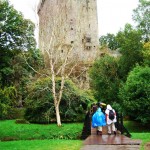Blarney Castle and the Stone of “Eloquence” (Ireland)
Blarney Castle and Blarney Stone Blarney is a town and townland in County Cork, Ireland. It lies 8 km north-west of Cork and is famed as the site of Blarney Castle, home of the legendary Blarney Stone.
Blarney Castle is the third fortress built on that spot. The castle originally dates from before A.D. 1200, when a wooden structure was built on the site. Around 1210 A.D. this was replaced by a stone fortification. It was destroyed in 1446, but subsequently rebuilt by Cormac Laidir MacCarthy, Lord of Munster.
In XVI century Queen Elizabeth I wanted to obtain the castle. She sent count Lester to the castle, a confidant of hers. But every time he tried to make an arrangement about surrender of the castle, the MacCarthys gave the queen’s agent a feast or devised other ways how to bide time. When the queen required of Lester a report about how he was doing, he escaped with a long letter full of flowery expressions. As a result the castle was never given to the queen. In XVII century the castle was besieged by lord Broghill, a general of Cromwell. During the siege of the castle its walls were very much damaged. But when Broghill and his people entered the castle, it turned out that its inhabitants had taken all the most precious things (including golden dishes) and gone through the Badger Caves – a system of underpasses beneath the castle. One of the lines of the Badger Caves led to a lake. Blarney’s new owner tried to dry the lake thinking that the runaways threw the golden table dishes into it but to no avail – there was nothing on the bottom of the lake.
In 1314 Dermot’s ancestor Cormac MacCarthy sent from Munster 4000 of his subjects to help Robert the Bruce in the battle at Bannockburn where the latter fought against English king Edward II. Bruce won and in sign of thankfulness gave Cormac a half of the Stone of Scone. There is a long list of explanations on the origin of this relic. As legend has it, Scota, pharaoh Ramses II’s daughter, left her motherland and roamed throughout the whole world for hundreds of years in search of the place that would become her new promised land. The journey brought her to the shore of Northern Ireland where she settled. Together with her husband Gatela, the king of the Scythians, she originated Scots and Picts. While traveling Scota always carried with her a great sandstone. It is with this stone under his head that Jacob saw a wonderful dream with a stairway to heaven down and up which angels were descending and ascending. The relic was kept in Scone Abbey in Scotland; English and Scotch kings were crowned sitting on it. All this explains numerous names of the sandstone: the Stone of Fate, Jacob’s pillow, the coronation stone.
In Blarney Castle the Stone is built into the wall of the castle at a considerable height. As tradition has it, a person who kisses this stone will become eloquent and lucky – at all times eloquence was believed to be a precious gift; it helped in politics, war and love.
World statesmen, literary giants and legends of the silver screen along with millions of simple tourists climb steep steps of Blarny Castle to reach the stone. Before the visitors had to be held literally by the heels and lowered upside down beyond the wall of the castle so that they might touch the famous stone. Of course, it was dangerous! Today the proprietors of Blarney Castle take care of their visitors’ safety more. The stone is still in the stone-work of the wall beneath the parapet. But now to kiss the stone a person must grab the hand-rail and lean backwards setting one’s feet on the footbridge that are on the very top of Blarny Castle. The Irish are also firmly convinced that whoever kisses this stone receives a special gift of eloquence, enabling him to win the heart of any woman. For if one looks in an English explanatory dictionary one will find that a verb “to blarney” means flattering, or coaxing talk.
Pages: 1 2
Один комментарий
Leave a Comment
You must be logged in to post a comment.


Согласно традициям Техасского технологического университета , c 1939 года один из хранящихся у них камней выдаётся за пропавший обломок камня Красноречия